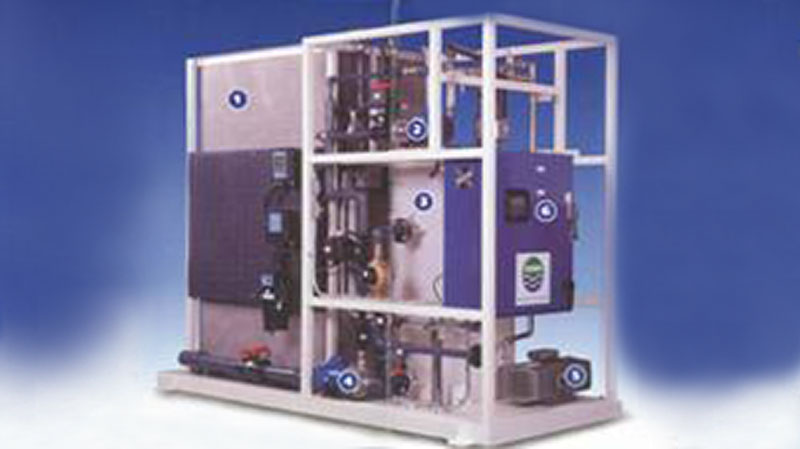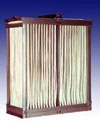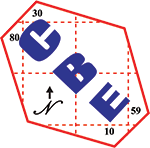
center
ZENON WASTEWATER TREATMENT SYSTEM
From commercial projects in the United States to upscale resort developments in the Caribbean with strict water conservation guidelines, ZENON’s membrane technology offers cost-effective development opportunities that are in harmony with the environment.
no-repeat;center top;;
auto
20px 0 0 15px

center

center
ZENON has the best wastewater purifying systems to meet or exceed the world’s toughest discharge requirements. This is why land developers have consistently chosen our membrane systems for schools, shopping malls, golf courses and resorts.
The modular membrane systems can be installed in virtually any location. In fact, with their small footprints, ZENON systems are a key part of many award-winning designs because they blend easily into the surroundings and are free of unpleasant odors.
If a wastewater treatment plant already exists, membrane technology is able to immediately upgrade the quality of the effluent and the capacity of the plant by up to three times, with no additional tank construction. These units are simple to operate and can even be controlled remotely by computer.
The effluent quality produced by the membrane system is so high that it can be immediately reused for landscape irrigation or for toilet flush water. The reuse of treated wastewater reduces the amount of fresh water drawn from the environment by up to 85%, greatly reducing operating costs.
For resorts that rely on desalination to provide fresh water, the reuse of wastewater for irrigation and toilets represents a significant savings, as the cost per gallon is only a fraction of the cost of desalination.
ZENON membrane technology – providing solutions to land development challenges.
no-repeat;center top;;
auto

center
ZeeWeed® 500
A ZeeWeed® 500 based water treatment process involves producing treated water by drawing the water through the membrane fibers in an “outside – in” flow path under a slight vacuum. ZeeWeed® membrane fibers are installed directly in the tank of water to be filtered and replace both the clarifier and the granular media filters of conventional drinking water or wastewater treatment systems.
The ZeeWeed® membrane has been approved by the National Sanitation Foundation (NSF) as an ultrafilter (UF). The outside surface of the fiber is a highly water permeable polymeric membrane and will remove biological contaminants, particulates and colloidal species from water, including:
- Turbidity
- Bacteria
- Cysts and Oocysts
- Fe and Mn
no-repeat;center top;;
auto
ZeeWeed® 500 Target Applications
The membranes are versatile and can be used in both water treatment and wastewater treatment applications. They are intended for applications with medium to high suspended solids concentrations. The target applications have been divided into two groups:
1) Water Treatment (Direct Filtration):
-
Municipal drinking water treatment: membrane filtration of surface or ground water to produce potable water. Membrane filtration can also be combined with:
-
enhanced coagulation (for organics and arsenic removal)
-
chemical oxidation (for iron and manganese removal)
-
powdered activated carbon addition (for taste and order removal) to achieve particular effluent requirements
-
-
Reverse osmosis (RO) pretreatment: membrane filtration of surface water or ground water to reduce SDI of RO feed
-
Tertiary treatment: membrane filtration of secondary effluent from wastewater processes for recycle/reuse or simply to ensure optimum quality effluent is continuously discharged
2) Wastewater Treatment (Membrane Bioreactor Systems):
-
Municipal/industrial wastewater treatment: combining membrane filtration with a conventional activated sludge process to treat a variety of municipal or industrial wastewaters.
-
Shipboard wastewater treatment: for wastewater treatment on a variety of ocean-going vessels.
-
Commercial or private development wastewater treatment: for property owners who wish to treat their wastewater on the premises (typically because they cannot be connected to a municipal sewer because of capacity limitations or distance).
In wastewater treatment, the combination of membrane filtration and biological treatment is otherwise known as “membrane bioreactors” and is offered by ZENON as the ZeeWeed® MBR Membrane Bioreactor process. In this process, the ZeeWeed® membrane serves to replace the clarifier in a wastewater treatment system. The benefits of substituting a ZeeWeed® membrane for the clarifier are significant and include:
-
Tertiary quality effluent is produced without extra equipment since the membrane is an absolute barrier to suspended and colloidal solids
-
Capacity of existing wastewater treatment plants can be increased without requiring more tanks as the MLSS in the activated sludge tank can be increased to 10,000 – 12,000 mg/l
-
Nutrient removal is improved because of the effective retention of suspended solids by the membrane
no-repeat;center top;;
auto
ZeeWeed® 500 Membrane Fiber
The membrane is a reinforced fiber with a nominal pore size of 0.04 µm.
no-repeat;center top;;
auto
ZeeWeed® 500 Module
The membrane module is the building block of the system. An individual membrane module is the smallest replaceable unit within a ZeeWeed® filtration system. The ZeeWeed® 500 membrane module consists of hundreds of membrane fibres oriented vertically between two headers. The hollow fibres are slightly longer than the distance between the top and bottom headers and this allows them to move when aerated. It is the air that bubbles up between the fibers that scours the fibers and continuously removes solids from the surface of the membrane.
no-repeat;center top;;
auto
ZeeWeed® 500 Cassette
A cassette is the smallest operable unit of the filtration system. Standard cassette configurations are available ranging in size from 1 -36 modules.
no-repeat;center top;;
auto
ZeeWeed® 500 System Design
A system typically consists of a 2 or more parallel trains. Each train consists of:
-
a process pump
-
automatic valves
-
instrumentation
The following components are generally required in a system and can either be dedicated to a specific train or shared amongst trains:
-
a tank (into which cassettes are immersed)
-
metering pumps (for chemical addition)
-
membrane blowers (to provide air for scouring the membranes)
-
reject or sludge pump
-
vacuum pump (for entrained air removal)
-
“clean-in-place” pumps
-
backpulse or wash tank
-
control system
Other components may or may not be needed depending on the design or application:
-
strainers (for pre-screening the feedwater)
-
process blowers (biological treatment systems only)
-
feed pumps
-
mixers
-
sludge recirculation pumps
-
cassette removal hoist or other mechanism
no-repeat;center top;;
auto
CONTACT US
#260d6a
#525c91
2px
40px 30px 30px 30px
http://www.cbebvi.com/contact/
dark

ZENON WASTEWATER TREATMENT SYSTEM
From commercial projects in the United States to upscale resort developments in the Caribbean with strict water conservation guidelines, ZENON's membrane technology offers cost-effective development opportunities that are in harmony with the environment.


ZENON has the best wastewater purifying systems to meet or exceed the world's toughest discharge requirements. This is why land developers have consistently chosen our membrane systems for schools, shopping malls, golf courses and resorts.
The modular membrane systems can be installed in virtually any location. In fact, with their small footprints, ZENON systems are a key part of many award-winning designs because they blend easily into the surroundings and are free of unpleasant odors.
If a wastewater treatment plant already exists, membrane technology is able to immediately upgrade the quality of the effluent and the capacity of the plant by up to three times, with no additional tank construction. These units are simple to operate and can even be controlled remotely by computer.
The effluent quality produced by the membrane system is so high that it can be immediately reused for landscape irrigation or for toilet flush water. The reuse of treated wastewater reduces the amount of fresh water drawn from the environment by up to 85%, greatly reducing operating costs.
For resorts that rely on desalination to provide fresh water, the reuse of wastewater for irrigation and toilets represents a significant savings, as the cost per gallon is only a fraction of the cost of desalination.
ZENON membrane technology - providing solutions to land development challenges.

ZeeWeed® 500
A ZeeWeed® 500 based water treatment process involves producing treated water by drawing the water through the membrane fibers in an "outside - in" flow path under a slight vacuum. ZeeWeed® membrane fibers are installed directly in the tank of water to be filtered and replace both the clarifier and the granular media filters of conventional drinking water or wastewater treatment systems.
The ZeeWeed® membrane has been approved by the National Sanitation Foundation (NSF) as an ultrafilter (UF). The outside surface of the fiber is a highly water permeable polymeric membrane and will remove biological contaminants, particulates and colloidal species from water, including:
- Turbidity
- Bacteria
- Cysts and Oocysts
- Fe and Mn
ZeeWeed® 500 Target Applications
The membranes are versatile and can be used in both water treatment and wastewater treatment applications. They are intended for applications with medium to high suspended solids concentrations. The target applications have been divided into two groups:
1) Water Treatment (Direct Filtration):
-
Municipal drinking water treatment: membrane filtration of surface or ground water to produce potable water. Membrane filtration can also be combined with:
-
enhanced coagulation (for organics and arsenic removal)
-
chemical oxidation (for iron and manganese removal)
-
powdered activated carbon addition (for taste and order removal) to achieve particular effluent requirements
-
-
Reverse osmosis (RO) pretreatment: membrane filtration of surface water or ground water to reduce SDI of RO feed
-
Tertiary treatment: membrane filtration of secondary effluent from wastewater processes for recycle/reuse or simply to ensure optimum quality effluent is continuously discharged
2) Wastewater Treatment (Membrane Bioreactor Systems):
-
Municipal/industrial wastewater treatment: combining membrane filtration with a conventional activated sludge process to treat a variety of municipal or industrial wastewaters.
-
Shipboard wastewater treatment: for wastewater treatment on a variety of ocean-going vessels.
-
Commercial or private development wastewater treatment: for property owners who wish to treat their wastewater on the premises (typically because they cannot be connected to a municipal sewer because of capacity limitations or distance).
In wastewater treatment, the combination of membrane filtration and biological treatment is otherwise known as "membrane bioreactors" and is offered by ZENON as the ZeeWeed® MBR Membrane Bioreactor process. In this process, the ZeeWeed® membrane serves to replace the clarifier in a wastewater treatment system. The benefits of substituting a ZeeWeed® membrane for the clarifier are significant and include:
-
Tertiary quality effluent is produced without extra equipment since the membrane is an absolute barrier to suspended and colloidal solids
-
Capacity of existing wastewater treatment plants can be increased without requiring more tanks as the MLSS in the activated sludge tank can be increased to 10,000 - 12,000 mg/l
-
Nutrient removal is improved because of the effective retention of suspended solids by the membrane
ZeeWeed® 500 Membrane Fiber
The membrane is a reinforced fiber with a nominal pore size of 0.04 µm.
ZeeWeed® 500 Module
The membrane module is the building block of the system. An individual membrane module is the smallest replaceable unit within a ZeeWeed® filtration system. The ZeeWeed® 500 membrane module consists of hundreds of membrane fibres oriented vertically between two headers. The hollow fibres are slightly longer than the distance between the top and bottom headers and this allows them to move when aerated. It is the air that bubbles up between the fibers that scours the fibers and continuously removes solids from the surface of the membrane.
ZeeWeed® 500 Cassette
A cassette is the smallest operable unit of the filtration system. Standard cassette configurations are available ranging in size from 1 -36 modules.
ZeeWeed® 500 System Design
A system typically consists of a 2 or more parallel trains. Each train consists of:
-
a process pump
-
automatic valves
-
instrumentation
The following components are generally required in a system and can either be dedicated to a specific train or shared amongst trains:
-
a tank (into which cassettes are immersed)
-
metering pumps (for chemical addition)
-
membrane blowers (to provide air for scouring the membranes)
-
reject or sludge pump
-
vacuum pump (for entrained air removal)
-
"clean-in-place" pumps
-
backpulse or wash tank
-
control system
Other components may or may not be needed depending on the design or application:
-
strainers (for pre-screening the feedwater)
-
process blowers (biological treatment systems only)
-
feed pumps
-
mixers
-
sludge recirculation pumps
-
cassette removal hoist or other mechanism
